Intercropping is the practice of growing different crops in the same field. There are many spatial combinations possible for intercropping, including mixed intercropping, in which different crops are planted in the same row or without regard to row, and row intercropping, which involves planting different crops in alternating rows. Crop rotation involves planting different crops on the same plot during different times of the year, and can include some of the benefits of intercropping, such as reducing insect pest populations, increasing beneficial insects, and weed suppression. In addition, non-crop plants such as weeds, cover crops, and habitat plantings can be combined in space and time to influence numbers of pest and beneficial arthropods on the main crop.
Crop Diversity
It is often stated that pests will be less damaging in fields with a mixture of crops than in fields with a single crop, also known as monocultures. This idea is based in part on the assumption that a given pest will find fewer acceptable hosts to feed or lay eggs on in a more diverse field. However, reviews of the literature indicate that insects that have a broad host range may not be reduced by diversifying crops (Andow 1991). Results can be mixed. For example, intercropping studies with whiteflies (Bemisia tabaci), which feed on a wide range of crops, have demonstrated a reduction in numbers by intercropping in some studies and not in others (Figure 1). Smith and McSorley (2000) and Smith et al. (2000, 2001) found no reduction in whitefly densities using eggplant or squash as trap crops, corn as a barrier crop, or mixtures of poor hosts as "diversionary" crops. However, Frank and Liburd (2005) found reduced numbers of Bemisia tabaci and aphids (several species) in a more diverse cropping system involving squash and a living mulch, buckwheat (Fagopyrum esculentum Moench).
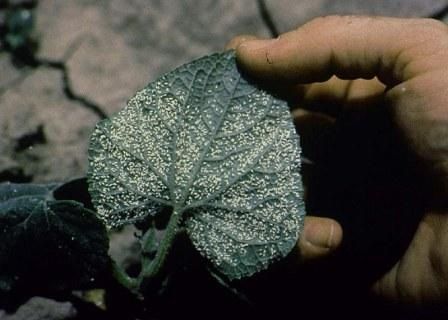
Credit: Hugh Smith
Research indicates that insects with a narrow host range, such as pests that only attack cruciferous crops, are more readily reduced in number when host crops are mixed with non-host crops (Andow 1991, Hooks and Johnson 2003). The diamondback moth, (Plutella xylostella), which only attacks cruciferous crops, is an example of a pest with a narrow host range (Fig. 2a–b). When an herbivore encounters a plant that it cannot feed on, it must expend additional time and energy searching for an acceptable plant. This reduces the time and energy the insect has to cause crop damage or deposit offspring, and in some instances it encourages the insect to migrate from the area. Insects rely on visual, olfactory, and tactile cues to find host plants. The presence of non-host plants can interfere with an insect's ability to detect host plants by physically masking the presence of the host plant or by producing volatiles that confuse the insect. In this sense, diverse habitat can reduce the "apparency" of host plants to pests (Figures 3–4).
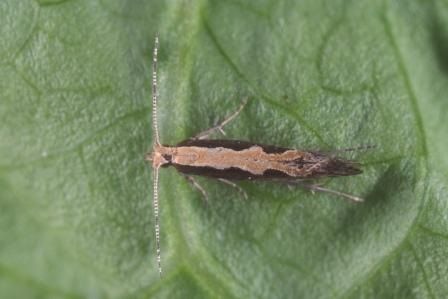
Credit: Lyle Buss
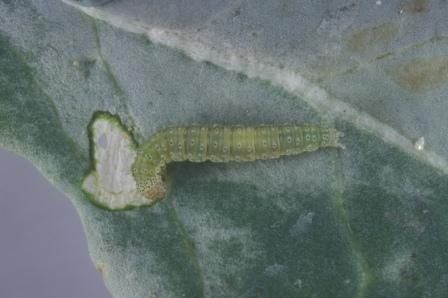
Credit: Lyle Buss
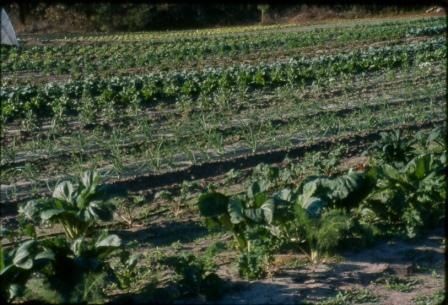
Credit: Hugh Smith
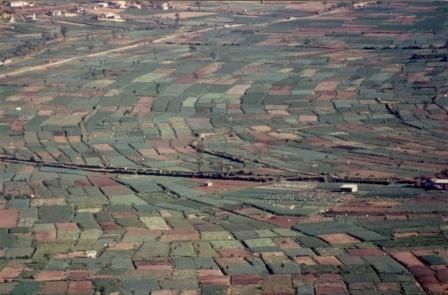
Credit: Hugh Smith
Host range and host-finding are two aspects of insect behavior that determine how an insect will react to a given crop mixture. The "resource concentration" hypothesis of intercropping and pest management states that it is easier for an herbivore to become abundant when the resources it needs to live and reproduce are concentrated in a monoculture than when these resources are diluted with non-host plants. This explanation for how intercropping can reduce pest densities implicates pests with a narrower rather than a broader host range.
Trap Cropping
Trap cropping relies on manipulating insect host-finding mechanisms and host preferences. A trap crop is a plant that draws a pest away from the main crop. Effective use of trap crops requires that insects concentrated on trap crops must be destroyed by spraying or tillage before they disperse to other plants. Trap crops can be intercropped with the main crop, although they are more often planted on the perimeter of the field containing the main crop. In some instances, the trap crop and the main crop are the same crop, but the trap crop is planted earlier than the main crop. Often when a pest becomes more abundant on one crop species than another, it is incorrectly assumed that the crop with high pest numbers may function as a trap crop. In order to serve as a trap crop, a plant species must draw pests away from the main crop, resulting in fewer pests on the main crop than if the trap crop were not present. Alfalfa has been used as a trap crop to draw Lygus (also known as the western tarnished plant bug, Lygus hesperus) away from main crop plantings of cotton and strawberries (Figure 5). However, the alfalfa must be carefully managed with insecticides, a bug-vac suction device, or timely cutting to prevent Lygus from building up and moving into strawberry or cotton (UC IPM 2011). In Florida, collard greens (Brassica oleracea var. acephala L.) have been used as a trap crop to suppress infestations of diamondback moth larvae in cabbage (Mitchell et al. 2000). While there are only limited cases of trap cropping being successfully used by growers, these two examples demonstrate that trap cropping can be used to manage generalist pests such as Lygus and specialist pests such as diamondback moth.

Credit: Hugh Smith
Living Mulches
Living mulches are minor crops that are planted within a major crop and can be considered as a type of intercropping. Living mulches may be planted on adjacent rows of the main crop, within the same row as the main crop and within close proximity of the main crop. Non crop plants are typically used as living mulches in vegetable systems including buckwheat and white clover, Trifolium repens L. Some benefits of using living mulches include reduced pest populations, increased densities of beneficial insects, and improvement in soil texture and structure because of the organic matter added to the soil (Frank and Liburd 2005, Nyoike and Liburd 2010). Nyoike and Liburd (2010) reported higher populations of beneficial insects when buckwheat was intercropped with squash as opposed to using UV-reflective mulch in squash plantings. Similarly, Frank and Liburd (2005) found lower pest pressure and higher beneficial insect populations in treatments containing buckwheat and squash compared with other conventional systems of growing squash in the absence of a living mulch (Figure 6).

Credit: Oscar Liburd
Natural Enemies
1. Floral Resources
Intercropping with insectary plants (also called companion plants) can be used to enhance the activity of predators and parasitoids by providing them with habitat and food sources such as nectar, pollen, and alternate hosts or prey. Pollen is an important source of protein and other nutrients for many beneficial arthropods, including pollinators, and nectar is an important energy and nutrient source (Jervis et al. 2005). Research in Florida has demonstrated that predatory minute pirate bugs (Orius spp.) can build to high numbers in sunflower (Helianthus annuus). Planting sunflower on the perimeter of pepper fields can increase the density of minute pirate bugs in the pepper, helping suppress western flower thrips (Funderburk et al. 2011). Parasitism of mole crickets in Florida by the introduced wasp, Larra bicolor is enhanced by the availability of nectar from flowering plants, Spermacoce verticillata and Chamaecrista fasciculata (Portman et al. 2010) (Figures 7–8). Strip-intercropping eggplant with dill (Anethum graveolens) increased predation of Colorado potato beetle (Leptinotarsa decemlineata ) egg masses by ladybird beetles and lacewings in New Jersey (Patt et al. 1997).
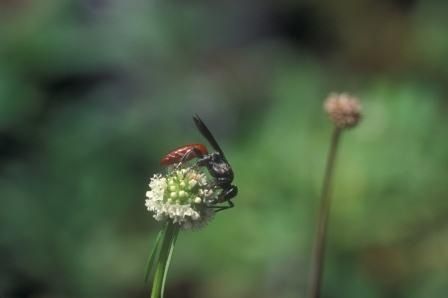
Credit: Lyle Buss
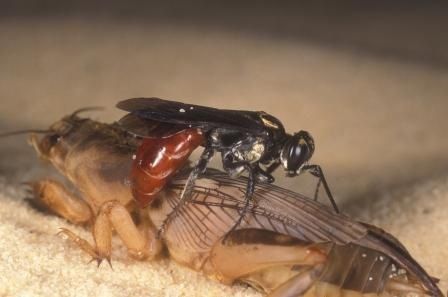
Credit: Lyle Buss
On the central coast of California, organic growers intercrop lettuce with sweet alyssum (Lobularia maritima) to enhance the activity of syrphid flies to suppress aphids in lettuce (Figure 9). There are many syrphid species that feed on nectar and pollen as adults (Figure 10), and feed on aphids as larvae (Figure 11) (Bugg et al. 2008). "Good bug blends" are used by primarily organic growers to provide floral resources to syrphids and other natural enemies for pest suppression Figure 12). Good bug blends are mixtures of seeds that flower at different times and so offer nectar and pollen at different times of the growing season. Weeds can also serve as sources of nectar and pollen for natural enemies (Figure 13).
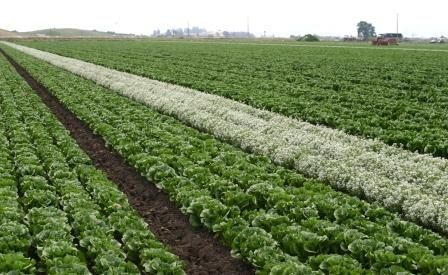
Credit: Hugh Smith
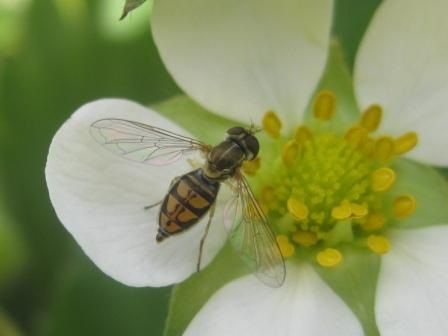
Credit: Hugh Smith
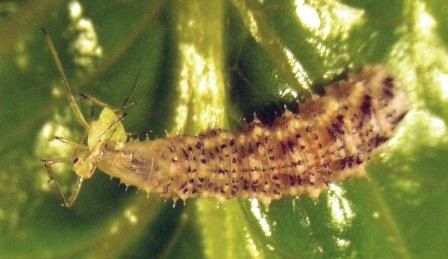
Credit: William Chaney
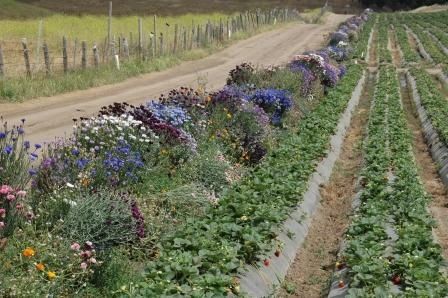
Credit: Joe Valdez
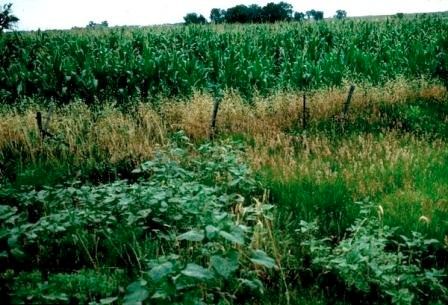
Credit: John Capinera
It is important to keep in mind that some pest species, such as thrips, leafminers, Lygus, and certain moths, can also benefit from the availability of floral resources. Densities of diamondback moth and imported cabbage worm were higher on broccoli inter-planted with certain flowers than broccoli planted alone (Zhao et al. 1992). In order to be effective, insectary plants must integrate easily into the farmer's production system, not become a weed, and not serve as a significant host for other insect pests and diseases.
2. Hedgerows and Beetle Banks
Hedgerows are lines of closely planted woody vegetation, sometimes with herbaceous vegetation present in the understory. Hedgerows are typically established between fields and can provide habitat and overwintering sites for a variety of natural enemies, including spiders and predatory beetles. Hedgerows can also be used to establish and maintain native species of vegetation. While there are many good reasons for conserving native species of plants, native species do not provide inherently better habitat for beneficial arthropods than introduced or non-endemic plant species. Hedgerows also provide habitat for birds and other wildlife, which can in some instances be detrimental to agricultural practices.
Beetle banks are ridges of land sown with the grassy vegetation typical of hedgerow understories. These areas provide habitat for predators and reduce the distance predators must travel to colonize the crop. Beetle banks have been evaluated primarily in Great Britain as a means to establish aphid predators in wheat fields (Collins et al. 2003).
3. Banker Plants
Banker plants are plants that are intentionally infested with an herbivore that serves as an alternate host or prey for a specific parasitoid or predator. The herbivore does not cause damage to the crop being grown for harvest. Presently, banker plants are primarily used in greenhouses, screenhouses, and other forms of protected agriculture to establish and maintain commercially available biocontrol agents (Osborne and Barrett 2005).
Examples of banker plants include winter barley to support bird cherry aphid (Rhopalosiphum padi) or wheat to support corn-leaf aphid (R. maidis) as alternate hosts for aphid parasitoids such as Aphidius colemani; papaya for establishing the papaya whitefly (Trialeurodes variabilis) as an alternate host for whitefly parasitoids (Figure 14); and corn or sorghum with the banks grass mite (Oligonychus pratensis) as alternate prey for Feltiella acarisuga and other spidermite predators.
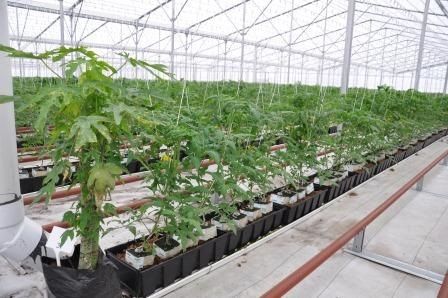
Credit: Hugh Smith
4. The "Enemies" Hypothesis
Another theory attempting to explain why pest damage is sometimes lower in diverse cropping systems suggests that crop mixtures provide a greater diversity of habitat for arthropods, and so offer a greater abundance and variety of prey and hosts for predators and parasitoids. This is referred to as the "enemies" hypothesis. Generalist predators such as certain spiders may have an advantage when a diversity of prey is available. However, specialist natural enemies, a group that includes most parasitoids and many of the predators that help suppress key agricultural pests, probably find their victims more quickly when the environment in which they are searching is uniform. Some of the original ground breaking studies on intercropping with brassicas demonstrated that natural enemies were more abundant and diverse in monocultures than in stands of mixed crop species (Pimentel 1961, Root 1973). A number of studies have indicated that the provisioning of floral resources and habitat can increase the density and diversity of natural enemies (cited above, and Jervis et al. 2005). However, crop diversity in itself probably does not enhance the efficacy of natural enemies.
Intercropping and Other Pest Management Strategies
Crop combining can be a stand-alone approach to pest management, or it can be combined with other pest management strategies, including chemical and biological control and the use of resistant plant varieties. The successful use of intercropping to manage pests depends on a thorough understanding of how distinct crop characteristics and combinations will influence the behavior of pest and beneficial arthropods. In addition, the challenges of combining crops in a manner that minimizes competition and assures acceptable yields must be addressed.
References
Andow, D. 1991. Vegetational diversity and arthropod population response. Annual Review of Entomology 36: 561–86.
Bugg, R. L., W. E. Chaney, R. G. Colfer, J. A. Cannon, and H. A. Smith. 2008. Flower flies (Diptera: Syrphidae) and other important allies in controlling pests of California vegetable crops. University of California, Division of Agriculture and Natural Resources, Publication 8285. University of California Press, Davis, CA.
Collins, K. L., N. D. Boatman, A. Wilcox, J. M. Holland, K. Chaney. 2002. Influence of beetle banks on cereal aphid predation in winter wheat. Agriculture, Ecosystems and Environment 93: 337–350.
Frank, D.L., and O.E. Liburd. 2005. Effects of living and synthetic mulch on the population dynamics of whiteflies and aphids, their associated natural enemies and insect-transmitted plant diseases in zucchini. Environmental Entomology 34: 857–865.
Funderburk, J., S. Reitz, P. Stansly, S. Olson, D. Sui, G. McAvoy, A. Whidden, O. Demirozer, G. Nuessly, and N. Leppla. 2011. Managing thrips in pepper and eggplant. University of Florida IFAS Extension Publication ENY 658. 11 pp.
Hooks, C. R. R., and M. W. Johnson. 2003. Impact of agricultural diversification on the insect community of cruciferous crops. Crop Protection 22: 223–238.
Jervis, M. A., and G. E. Heimpel. Phytophagy in insects as natural enemies; Jervis, M. A. Ed., Springer, Netherlands, 525–550.
Mitchell, E. R., G. Hu, and D. Johanowicz. 2000. Management of diamondback moth in cabbage using collard as a trap crop. Hort Science 35: 875–879.
Nyoike, T. W., and O. E. Liburd. 2010. Effect of living (buckwheat) and UV reflective mulches with and without imidacloprid on whiteflies, aphids and marketable yields of zucchini squash. International Journal of Pest Management 56: 31–39.
Osborne, L. S., and J. E. Barrett. 2005. You can bank on it: banker plants can be used to rear natural enemies to help control greenhouse pests. Ornamental Outlook (September) pp. 26–27 (https://mrec.ifas.ufl.edu/lso/banker/Documents/BANKERFoliage.pdf).
Patt, J. M., G. C. Hamilton, and J. H. Lashomb. 1997. Impact of strip-insectary intercropping with flowers on conservation biological control of the Colorado potato beetle. Advances in Horticultural Science 11: 175–181.
Pimentel, D. 1961. Species diversity and insect population outbreaks. Annals of the Entomological Society of America 54: 76–86.
Portman, S. L., J. H. Frank, R. McSorley, and N. C. Leppla. 2010. Nectar-seeking and host-seeking by Larra bicolor, a parasitoid of Scapteriscus mole crickets. Environmental Entomology 39: 939–943.
Root, R. 1973. Organization of a plant-arthropod association in simple and diverse habitats. The fauna of collards (Brassica oleracea). Ecological Monographs 43: 95–124.
Smith, H. A., and R. McSorley. 2000. Potential of field corn as a barrier crop and eggplant as a trap crop for management of Bemisia argentifolii on common bean in north Florida. Florida Entomologist. 83: 145–158.
Smith, H. A., R. L. Koenig, H. J. McAuslane, and R. McSorley. 2000. Effect of silver reflective mulch and a summer squash trap crop on densities of immature Bemisia argentifolii on organic bean. Journal of Economic Entomology 93: 726–731.
Smith, H. A., R. McSorley, and J. A. Sierra Izaguirre. 2001. The effect of intercropping common bean with poor hosts and nonhosts on numbers of immature whiteflies (Homoptera: Aleyrodidae) in the Salamá valley, Guatemala. Environmental Entomology 30: 89–100.
UC IPM website Strawberry Lygus Bug. https://www2.ipm.ucanr.edu/agriculture/strawberry/lygus-bug/. Consulted Dec 14 2011.
Zhao, J. Z., G. S. Ayers, E. J. Grafius, and F. W. Stehr. 1992. Effects of neighboring nectar-producing plants on populations of pest Lepidoptera and their parasitoids in broccoli plantings. Great Lakes Entomologist 24: 253–258.